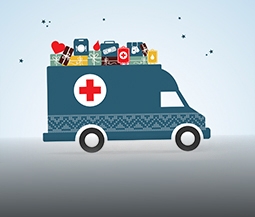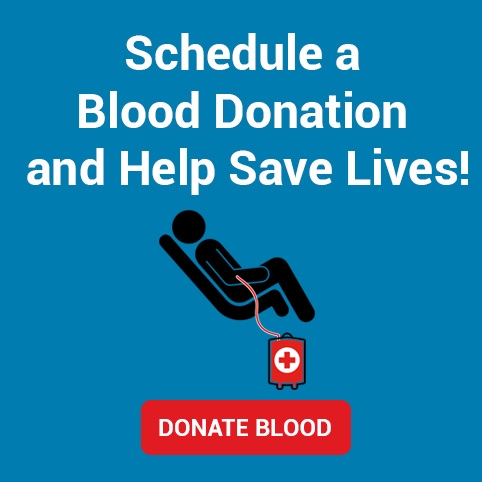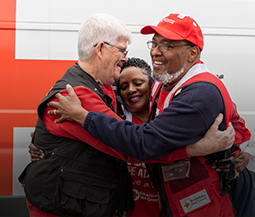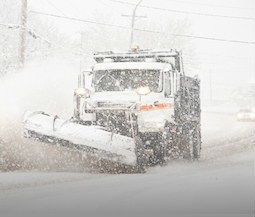American Red Cross disaster workers are on the ground helping as the dangerous cold weather affects most of the country. The Red Cross is monitoring the situation to add more help if necessary and offers steps people should follow to help them stay safe.
In addition, the weather is forcing the cancellation of Red Cross blood collections across the country. Since the start of the month, as many as 370 blood drives across 27 states have been canceled, causing more than 11,000 lifesaving blood and platelet donations to go uncollected. This comes at a critical time ─ the Red Cross has reported an emergency blood shortage, that blood and platelet donations are needed to ensure lifesaving medical procedures are not delayed. Learn more here.
Make an appointment to give blood or platelets now by using the Red Cross Blood Donor App, visiting RedCrossBlood.org or calling 1-800-RED CROSS (1-800-733-2767).
Millions of people from the Pacific Northwest to the East Coast, including the deep South, are under some kind of winter alert and people are being warned to stay inside if possible. Extremely cold air, snow, sleet and freezing rain have led to power outages, flight delays, dangerous driving conditions, closed schools and pipes bursting due to the cold. Portions of the Cascades into the Northern Rockies will see 15 to 28 inches of snow. And the National Weather Service reports another wave of Arctic air will hit the country later this week.
RED CROSS RESPONSE The Red Cross is helping state and local officials during the extreme cold, supporting shelters and warming centers across multiple states. In some areas, that support includes providing cots, blankets and relief supplies to community groups operating the facilities. Find open shelters on redcross.org, the free Red Cross Emergency app or by calling 1-800-RED CROSS (800-733-2767) and selecting the disaster option. You can also find shelters and warming centers by following your local Red Cross unit, county and city officials on social media or by monitoring local news.
Warming Centers are places where people can seek relief from the cold. They are a place for the community to gather during the day. An emergency shelter is open 24 hours a day and provides sleeping accommodations for those without an adequate place to sleep. Most warming centers can be converted to shelters if necessary.
YOU CAN HELP people affected by disasters like winter weather and countless other crises by making a gift to Red Cross Disaster Relief. Financial donations enable the Red Cross to prepare for, respond to and help people recover from disasters big and small. Visit redcross.org, call 800-RED-CROSS, or text the word REDCROSS to 90999 to make a $10 donation.
WINTER WEATHER SAFETY
The safest place to be during wintry weather is inside. Check on relatives, neighbors, and friends, particularly if they are elderly or live alone.
Caulk and weather-strip doors and windowsills to keep cold air out. Install storm windows or cover windows with plastic from the inside to provide an extra layer of insulation to keep cold air out.
Make sure you have enough heating fuel on hand. Lower the thermostat to 65° F (18° C) during the day and to 55° F (13° C) at night. Close off unused rooms, and stuff towels or rags in cracks under the doors. Cover the windows at night.
Stay indoors and wear layers of loose-fitting, lightweight, warm clothing.
If you must go outside, protect yourself from winter storm hazards:
Cover your mouth to protect your lungs from severely cold air.
Watch for signs of hypothermia and frostbite.
Avoid overexertion, such as shoveling heavy snow, pushing a vehicle, or walking in deep snow. The strain from the cold and the hard labor may cause a heart attack.
Walk carefully on snowy, icy sidewalks.
Stay off the roads if possible during severe weather.
If you must go out during a winter storm, use public transportation if possible.
Keep your vehicle’s gas tank full so you can leave right away in an emergency and to keep the fuel line from freezing.
Make sure everyone has their seat belts on and give your full attention to the road.
Don’t follow other vehicles too closely. Sudden stops are difficult on snowy roadways.
Don’t use cruise control when driving in winter weather.
Don’t pass snowplows.
Frostbite and hypothermia can quickly become life threatening. Be aware of the wind chill. Dress appropriately and avoid staying in the cold too long. Wear a hat and gloves when appropriate with layers of clothing. Get out of the cold immediately if the signals of hypothermia or frostbite appear. More information on frostbite and hypothermia is available here.
POWER OUTAGE SAFETY
Use flashlights in the dark — not candles.
Don’t drive unless necessary. Traffic lights will be out and roads could be congested.
Turn off and unplug any appliances, equipment and electronics. When the power comes back on, surges or spikes can damage equipment.
Never use a generator, grill, camp stove or other gasoline, propane, natural gas or charcoal-burning device inside a home, garage, basement or other partially enclosed area. Keep this equipment outside and away from doors, windows and vents, which could allow carbon monoxide to come indoors.
Download the free Red Cross First Aid app so you’ll know what to do if emergency help is delayed and the free Emergency app for weather alerts, open Red Cross shelter locations and safety steps for different emergencies. Choose whether you want to view the content in English or Spanish with an easy-to-find language selector. Find these and all of the Red Cross apps in smartphone app stores by searching for the American Red Cross or going to redcross.org/apps.












